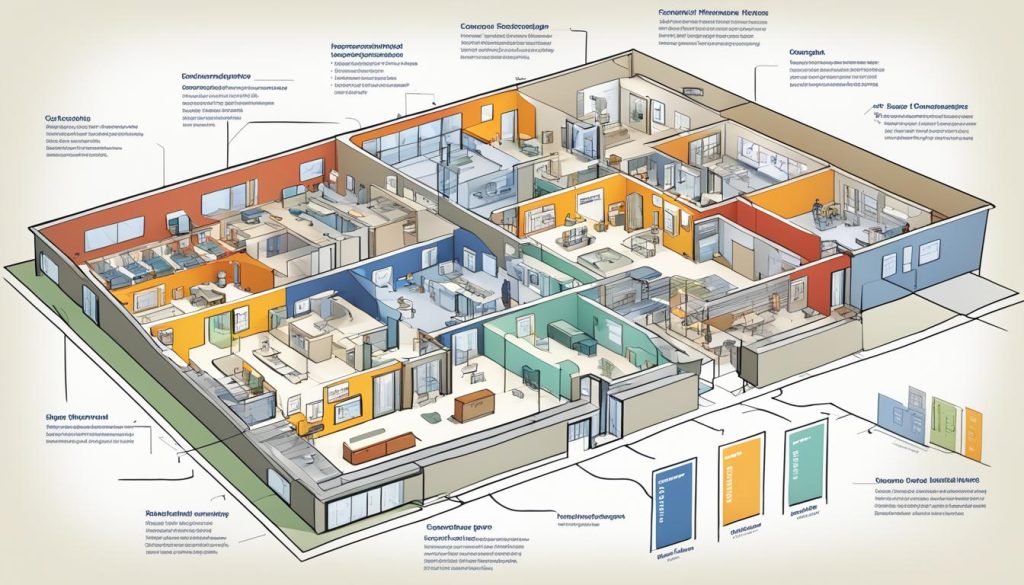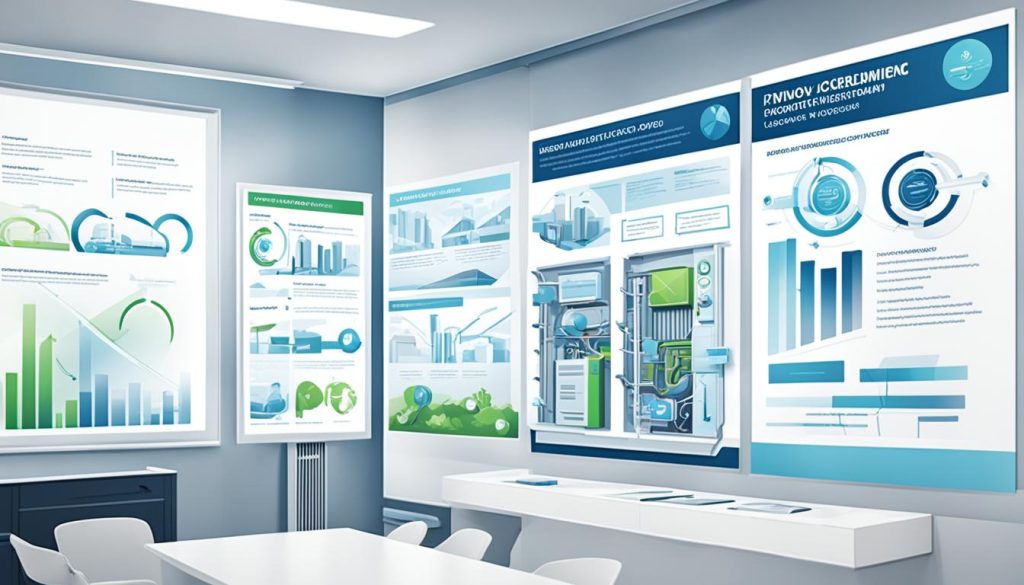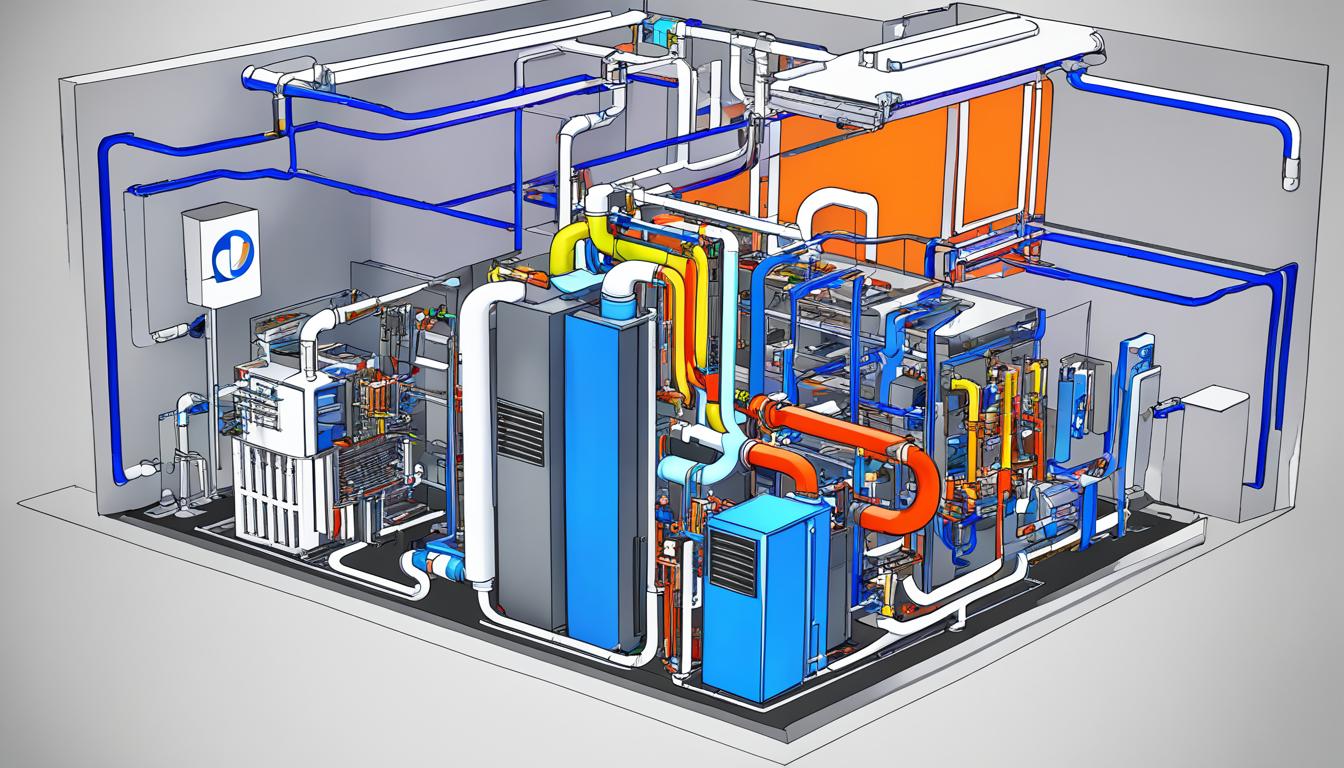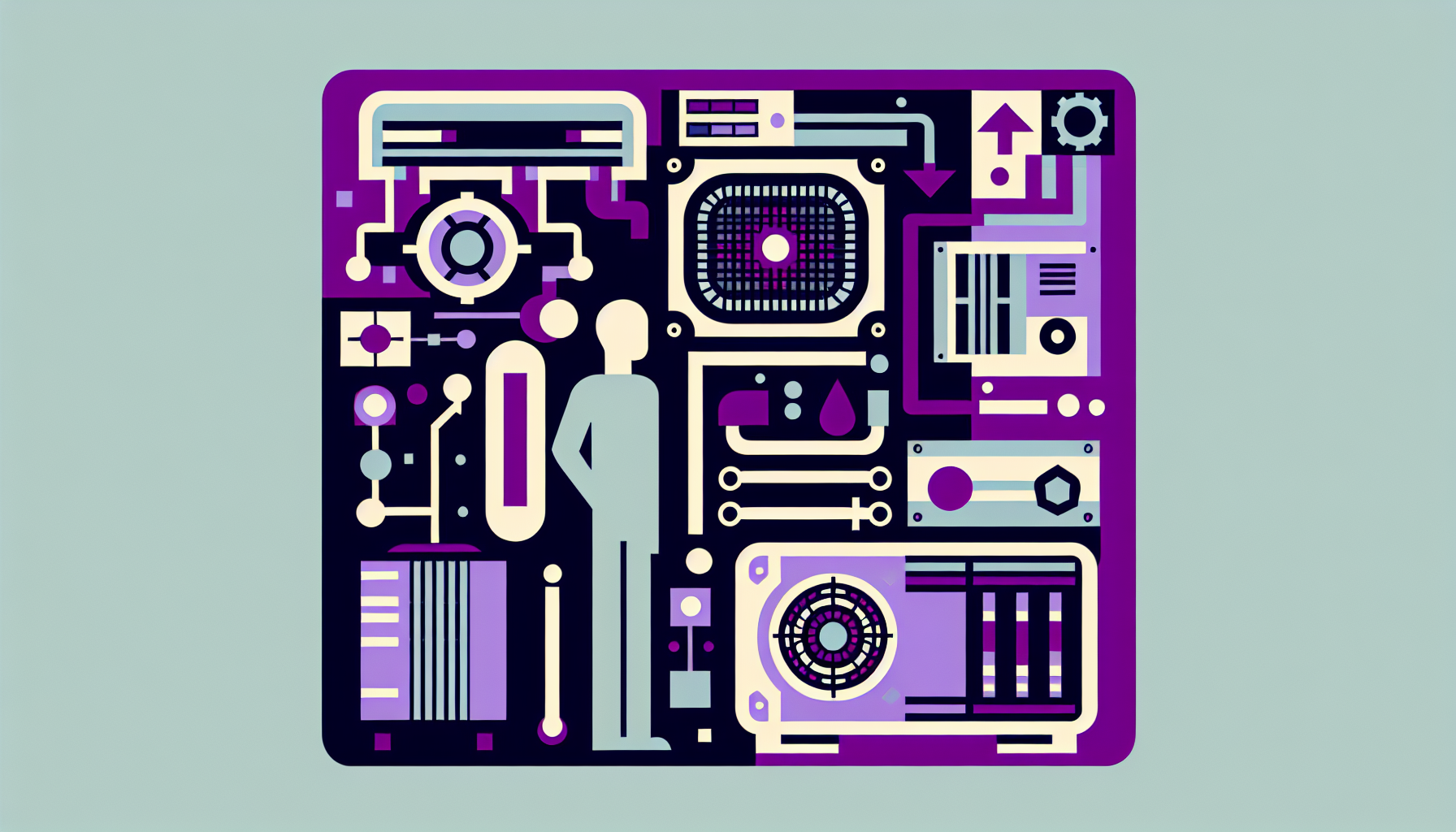To make HVAC design presentations stand out, mix clear visuals, deep technical knowledge, and content that fits the client’s needs. A good HVAC proposal must balance professional design with detailed system knowledge.
First, collect all the important details about what your client needs and the HVAC system you’re designing. Use this info to make a presentation that shows your solutions and answers their questions. Add visuals like infographics and isometric maps to make complex HVAC ideas easy to understand.
Use tools like Icograms Designer to make top-notch graphics for your presentation. It has a big icon library and customizable templates. This lets you create diagrams that clearly explain your HVAC solutions.
Make sure your content fits the client, whether they own a home or manage a commercial property. Include technical details and performance data to show the worth of your HVAC design. Presenting your HVAC solutions clearly and professionally helps build trust and boosts your chances of getting the project.
Understanding the Importance of HVAC Design Presentations
HVAC Design Visuals are key to winning clients and showing your skills. They make complex systems simple, setting you apart. Let’s see why these visuals are crucial for your success.
Building client trust through visual communication
Persuasive HVAC Presentations build trust with clients. Clear visuals show you get their needs and can solve their problems. This makes clients trust your skills and services more.
Demonstrating expertise and professionalism
Good HVAC Design Communication shows your skills. Quality visuals and detailed explanations prove you’re an expert. This can be what makes clients choose you over others.
Enhancing client understanding of complex HVAC systems
HVAC systems can be hard for those who don’t know much about them. Visuals make these complex ideas simple. This helps clients see what they’re buying and why it’s good for their comfort and efficiency.
| Presentation Element | Purpose | Impact on Clients |
|---|---|---|
| 3D System Layouts | Visualize installation | Clearer understanding of space usage |
| Energy Efficiency Graphs | Showcase cost savings | Persuades with tangible benefits |
| Comfort Zone Diagrams | Illustrate system effectiveness | Helps envision improved living conditions |
Mastering HVAC Design Visuals leads to Persuasive HVAC Presentations. These presentations inform and convince clients of your value. This visual approach to communication is key for successful projects and strong client relationships.
Gathering Essential Information for Your Presentation
Creating winning HVAC project proposals begins with gathering key data. It’s crucial to understand what your client needs and their challenges. This info is vital for clear HVAC design communication.
First, research your client’s industry. Is it all about saving energy? Do they want fast installation? This info helps shape your pitch. Then, learn about their building or facility. Size, age, and the current HVAC setup are important for designing the best system.
- Client’s industry and priorities
- Building specifications
- Current HVAC system details
- Budget constraints
- Timeline expectations
Also, look at your competition. What makes your HVAC solutions stand out? Show these unique points in your presentation. A good pitch mixes technical knowledge with clear, focused communication.
| Information Category | Examples | Importance |
|---|---|---|
| Client Needs | Energy efficiency, cost savings | High |
| Building Specs | Square footage, stories, age | Critical |
| Current System | Brand, age, efficiency rating | Important |
| Budget | Maximum spend, ROI expectations | Essential |
| Timeline | Installation deadline, phased approach | Significant |
With this info, you’re set to make a strong HVAC design presentation. It will directly address your client’s needs and highlight your skills.
Choosing the Right Tools for Creating HVAC Design Presentations
Choosing the right tools is key for making great HVAC Design Visuals. You need software that can handle complex diagrams and make your Effective HVAC Proposals stand out.
Popular Presentation Software
Tools like PowerPoint and Google Slides are good for basic HVAC layouts. But, they might not be enough for detailed system diagrams or 3D models.
Specialized HVAC Design Software
For Presenting HVAC Solutions, specialized software has more to offer. These tools let you create accurate system layouts and do calculations right in your presentation.
| Software | Key Features | Best For |
|---|---|---|
| AutoCAD MEP | Detailed 2D/3D designs | Complex commercial projects |
| Revit MEP | BIM integration | Large-scale, collaborative projects |
| SketchUp | Easy 3D modeling | Quick concept designs |
Icograms Designer for Infographics
Icograms Designer is great for making infographics for HVAC design presentations. It has a huge icon library for building clear, professional diagrams fast. You can make isometric maps and flowcharts that simplify complex systems.
With these tools, you can make presentations that look professional and clearly explain your HVAC solutions to clients.
Structuring Your HVAC Design Presentation
Creating effective HVAC project proposals needs a clear structure. Your aim is to give persuasive presentations that show your skills and attract clients. Let’s look at the main parts to include in your structure.

Begin with an executive summary that highlights the main benefits of your HVAC solution. This catches the client’s eye and sets the proposal’s tone. Then, outline the client’s specific needs and challenges you’ve spotted.
Next, show your proposed HVAC system design. Focus on how it meets the client’s needs. Use clear visuals and diagrams to show the main parts and what they do.
Include a section on energy efficiency and cost savings. Clients like proposals that show long-term gains. Offer specific data on how your system will improve performance and save money.
Finish with a clear call-to-action. Explain the next steps and push the client to choose your proposal.
| Presentation Section | Key Content | Purpose |
|---|---|---|
| Executive Summary | Project overview, main benefits | Capture attention, highlight value |
| Client Needs Analysis | Identified challenges, requirements | Demonstrate understanding |
| Proposed Solution | System design, components, features | Showcase expertise, address needs |
| Energy Efficiency | Performance data, cost savings | Prove long-term value |
| Call-to-Action | Next steps, timeline | Encourage client commitment |
By using this structure, you’ll make HVAC project proposals that clearly share your solutions. This will help you win more projects.
Incorporating Visual Elements to Enhance Understanding
HVAC Design Visuals are key to showing HVAC Solutions to clients. They make complex HVAC System Designs clear and grab client attention.
Using infographics and diagrams
Infographics and diagrams make HVAC systems easy to understand. They should look good and show how energy-efficient your system is. They also highlight the parts of the system and how air moves through it.
This makes it clear to clients how your HVAC solutions work.
Creating isometric maps of HVAC systems
Isometric maps give a 3D view of HVAC layouts. This helps clients see how different parts fit together in a building. They show where ducts and equipment go and how everything works together.
Leveraging Icograms’ extensive icon library
Icograms has lots of icons just for HVAC presentations. Use these icons to make your visuals look professional fast. They have icons for all kinds of HVAC parts, making it simple to show your system design.
| Visual Element | Purpose | Impact on Client Understanding |
|---|---|---|
| Infographics | Simplify complex data | Improves comprehension of system benefits |
| Isometric Maps | Show spatial relationships | Enhances understanding of system layout |
| Icogram Icons | Represent HVAC components | Facilitates quick recognition of system parts |
Create Impressive Design Presentations for Clients
Making great HVAC presentations is key for talking to clients well. Use visuals to make complex systems easy to understand. Videos are great for showing off your skills and gaining trust with potential customers.
Begin by making how-to videos for basic HVAC upkeep. This shows your business is ready to help and knows a lot. Add these videos to your presentations to show you care about teaching your customers.

Use infographics to make energy efficiency and system performance easy to grasp. These visuals turn hard info into something simple. Show before-and-after examples to show how your HVAC designs make a difference.
| Presentation Element | Purpose | Impact on Client |
|---|---|---|
| How-to Videos | Educate on maintenance | Builds trust and credibility |
| Infographics | Simplify technical data | Enhances understanding |
| 3D Renderings | Visualize HVAC layouts | Improves spatial comprehension |
| Cost-saving Charts | Highlight financial benefits | Encourages investment decisions |
Customize your HVAC design talks for each client. Use simple language and skip the hard words to make sure they get your point. By mixing these ideas, you’ll make presentations that teach and convince at the same time.
Tailoring Your Presentation to Different Client Types
Creating effective Client Presentations for HVAC projects means knowing your audience well. Winning HVAC Pitches is all about matching your message to what clients need. Let’s see how to adjust your approach for different clients.
For residential clients, talk about comfort and saving on energy bills. Show how your solutions are easy to use and won’t break the bank. Commercial clients care about how efficient and long-lasting a system is. Talk about how your HVAC can save them money over time.
Industrial clients want systems that can take a lot of wear and tear. Show off your skills in making HVAC systems that are tough and meet tough standards. Government clients focus on following energy rules and being green. Highlight how your HVAC meets these goals.
| Client Type | Key Focus Areas | Presentation Strategies |
|---|---|---|
| Residential | Comfort, Energy Savings | User-friendly visuals, Cost breakdowns |
| Commercial | Efficiency, Performance | ROI charts, Operational benefits |
| Industrial | Resilience, Compliance | Technical specs, Regulatory adherence |
| Government | Sustainability, Standards | Energy efficiency metrics, Green certifications |
Successful HVAC Project Proposals mix technical know-how with easy-to-understand language. Adjust your words, pictures, and numbers to fit each client’s needs. By changing how you present, you’ll boost your chances of winning pitches in various markets.
Including Technical Specifications and Performance Data
In HVAC system design, technical details are key. Your proposal should highlight important performance metrics to stand out. This makes your HVAC solutions clear and valuable to clients.
Presenting energy efficiency metrics
Use Icograms Designer for eye-catching infographics on energy efficiency. Include SEER and EER values for cooling, and AFUE ratings for heating. These visuals show how your design can cut energy bills.
Showcasing system capacity and performance
Use clear charts to show your HVAC system’s capacity. Include cooling and heating loads, airflow rates, and temperature control ranges. This proves your design fits the client’s needs and building specs.
Highlighting cost-saving features
Create a table to show long-term savings. List initial costs, operational expenses, and estimated energy savings over time. This helps clients see the financial perks of your HVAC solution, making your proposal more appealing.





0 Comments